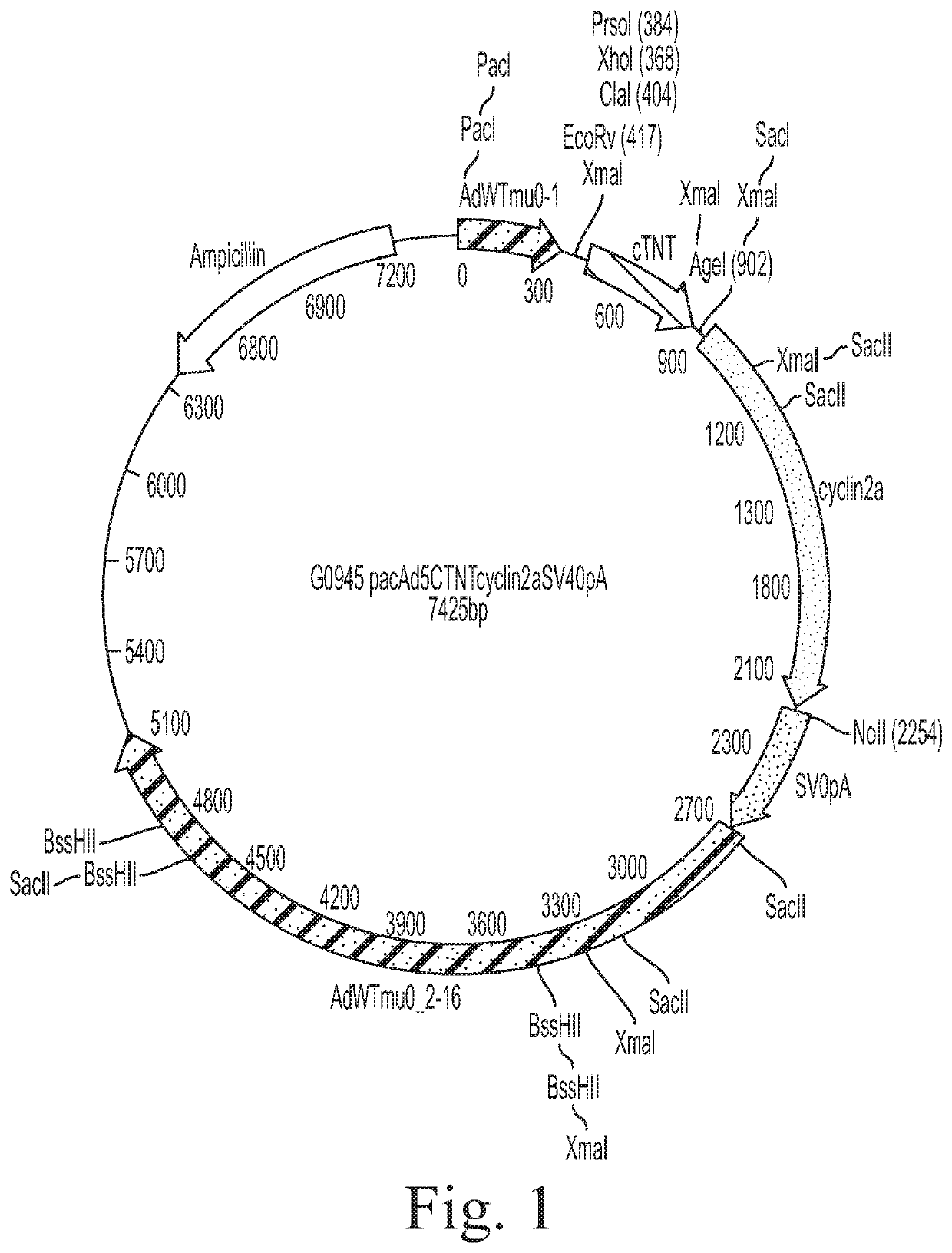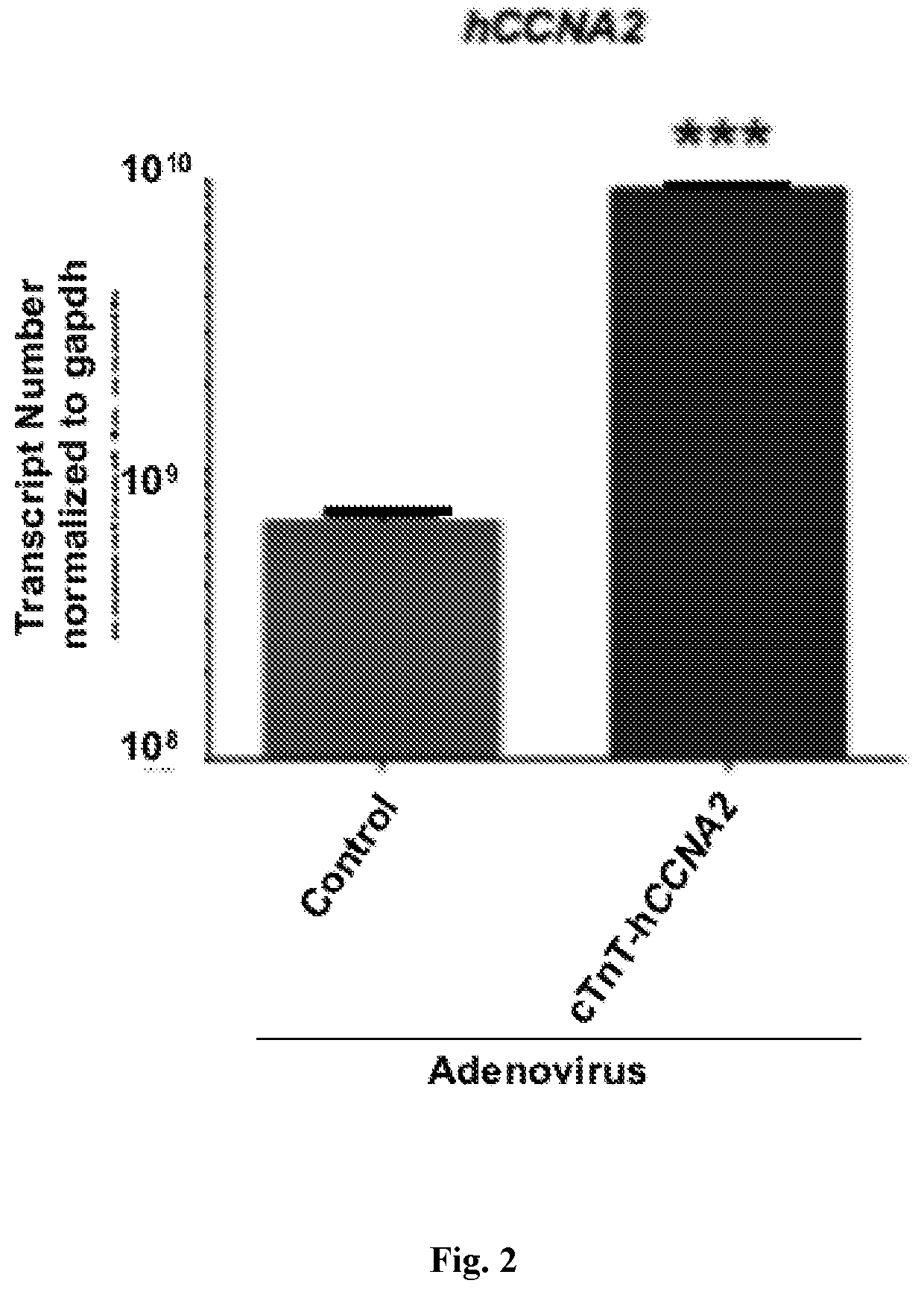Compositions and methods for the treatment of heart disease
a technology for heart disease and compositions, applied in the field of molecular biology and medicine, can solve the problems of reducing the clinical value of heart disease, so as to improve the cardiac ejection fraction and increase the cardiac output.
- Summary
- Abstract
- Description
- Claims
- Application Information
AI Technical Summary
Benefits of technology
Problems solved by technology
Method used
Image
Examples
example 1
a Therapeutic Use Grade, Human CCNA2 Adenovirus Vector
[0076]This Example demonstrates that a cTnT-CCNA2 adenovirus vector can be used to induce expression of CCNA2 in cultured adult human cardiomyocytes.
A. Methods
I. Culture of Adult Human Cardiomyocytes
[0077]Cardiomyocytes from adult human heart tissue (55-year-old male who died of a non-cardiac cause) were isolated after enzymatic digestion at Anabios, San Diego, Calif. and were processed within 24 h. Adult human cardiomyocytes were subjected to the following culture conditions: Cells were washed with serum free DMEM media twice and 105 cells were seeded in 100-mm untreated polystyrene plates (Fisher Scientific). Non-adherent cells were collected every 24 h and centrifuged at 20 g for 2 min at room temperature. The cell pellet was washed with serum-free DMEM and seeded on new polystyrene plates in modified Cardiomyocyte Culture Media22 (mod CMC) formulated by adding 13% FBS, 2.5% horse serum, lx nonessential amino acid, 1 mM sodium...
example 2
Therapeutic Use Grade, Human CCNA2 Adenovirus Vector for Promoting Cytokinesis in Adult Human Cardiomyocytes
[0080]This Example illustrates that adenoviral vector mediated expression of CCNA2 induces cytokinesis in cultured adult human cardiomyocytes.
A. Methods
I. Time-Lapse Microscopy
[0081]To capture cell division events in cardiomyocytes in vitro, live cell epifluorescence time-lapse microscopy were carried out using a Zeiss AxioVision Observer Z1 (Carl Zeiss, Thornwood, N.Y., USA) inverted epifluorescence microscope in a humidified chamber in the presence of 5% CO2 at 37° C. Multiple random points with cells expressing eGFP (green) and mCherry (red) were selected in the test and control groups. The positions were marked with the “position-list” tool in the AxioVision microscopy software (AxioVision Release 4.7, Carl Zeiss). After the first cycle of imaging, only the channel for Texas red was used (for detection of mCherry) to acquire images for 72 h. The fluorescein isothiocyanate ...
PUM
| Property | Measurement | Unit |
|---|---|---|
| time- | aaaaa | aaaaa |
| time | aaaaa | aaaaa |
| temperature | aaaaa | aaaaa |
Abstract
Description
Claims
Application Information
 Login to View More
Login to View More - R&D
- Intellectual Property
- Life Sciences
- Materials
- Tech Scout
- Unparalleled Data Quality
- Higher Quality Content
- 60% Fewer Hallucinations
Browse by: Latest US Patents, China's latest patents, Technical Efficacy Thesaurus, Application Domain, Technology Topic, Popular Technical Reports.
© 2025 PatSnap. All rights reserved.Legal|Privacy policy|Modern Slavery Act Transparency Statement|Sitemap|About US| Contact US: help@patsnap.com



